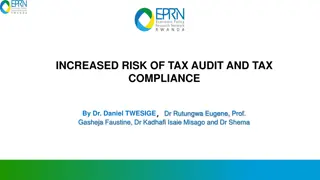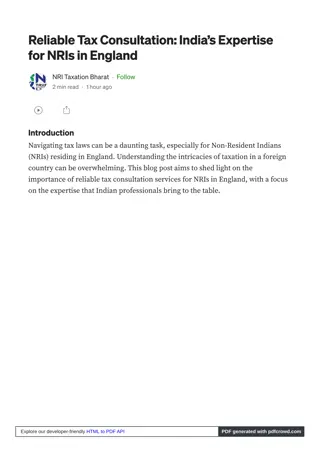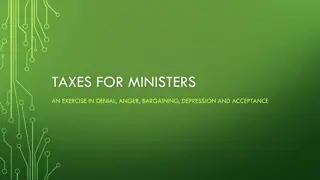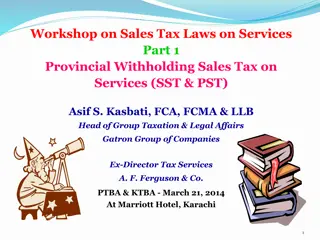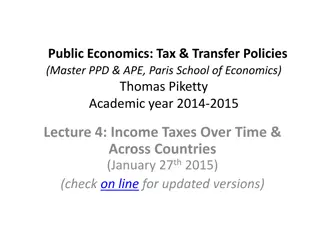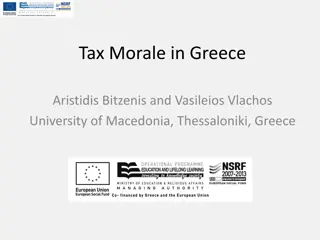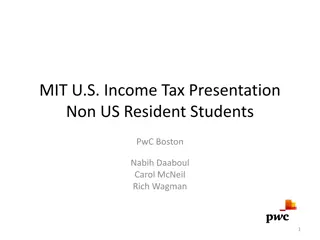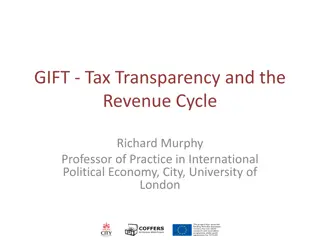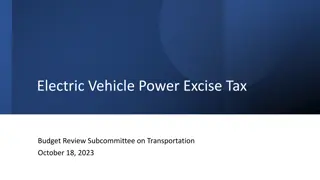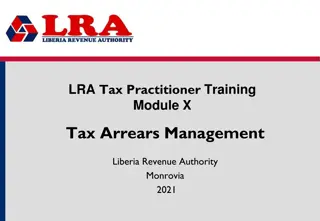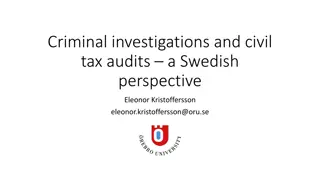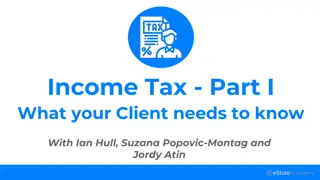Mastering Tax Court Stipulations: Key Practices and Procedures
This presentation provides valuable insights into the Tax Court stipulation process, focusing on Rule 91 stipulations, the importance of comprehensive stipulations, best practices in preparing stipulations of facts, evidentiary issues, and the essential elements of filing a stipulation for trial. An emphasis is placed on the voluntary exchange of facts and documents between parties for efficient case resolution in Tax Court proceedings.
Download Presentation

Please find below an Image/Link to download the presentation.
The content on the website is provided AS IS for your information and personal use only. It may not be sold, licensed, or shared on other websites without obtaining consent from the author. Download presentation by click this link. If you encounter any issues during the download, it is possible that the publisher has removed the file from their server.
E N D
Presentation Transcript
Navigating the Tax Court Stipulation Process LITC Grant Conference Wed. Dec. 4, 2019 Presenters: The Honorable Diana L. Leyden, Special Trial Judge, United States Tax Court Paul Kurth, Director, Low Income Taxpayer Clinic; Managing Director, Columbus Community Legal Services; Director of Experiential Curriculum, Catholic University of America Columbus School of Law Deborah Aloof, Senior Counsel (Small Business/Self- Employed), IRS Office of Chief Counsel Disclaimer: Any views expressed in this presentation reflect the unofficial, individual views of the individual speakers and do not necessarily represent the policies of the U.S. Tax Court, the IRS, or any other organization.
What we will cover today Stipulations for Trial (Tax Court Rule 91) vs. Stipulation of Settled Issues. How to solve problems through the effective use of stipulations of facts and exhibits in Tax Court. Best practices in preparing a stipulation of facts. Evidentiary issues. Motions to compel. Raising the stipulation of issues in pre-trial conference calls, at calendar call. 2
Stipulation process is the bedrock of Tax Court Practice For many years the bedrock of Tax Court practice has been the stipulation process, now embodied in Rule 91. Essential to that process is the voluntary exchange of necessary facts, documents, and other data between the parties as an aid to the more expeditious trial of cases as well as for settlement purposes. The recently adopted discovery procedures were not intended in any way to weaken the stipulation process. See Rule 91(a)(2). Branerton Corp. v. Commissioner, 61 T.C. 691, 692 (1974). 3
Stipulations for Trial Required to stipulate to the fullest extent possible. Stipulate to all matters not privileged- evidentiary privileges and sec. 6103. Stipulate to what is relevant to the case. Stipulate matters that involve either fact or opinion or the application of law to fact. Court is not bound to accept a stipulation as to questions of law. Est. of Saia v. Commissioner, 61 TC 515 (1974). 4
Stipulations are to be comprehensive Rule 91(a)(2): Can/should stipulate to matters that could have been obtained through discovery? Failure to include matters admitted under Rule 91(f)? 5
Form of a Stipulation for Trial Must file with the Judge 2 copies of the stipulations- Best practice- bring 4!- and one copy of the exhibits- Best practice bring 3 copies of the exhibits. Separate paragraphs. Try not to put more than 2 sentences in each paragraph. Numbering exhibits: Sequential # plus a letter: e.g., 1-J; 2-P; 3-R J for Joint (offered by both petitioner and respondent) P for petitioner R for respondent 6
What to include in stipulations for trial All facts- what are examples of typical facts in a small case? All documents- what are examples of typical documents in a small case? All evidence which fairly should not be in dispute- e.g., a tax return. 7
Materiality and relevancy If truth or authenticity is not disputed, other side can reserve an objection. Objection on the grounds of materiality or relevancy should be noted. Objection to a fact or exhibit IS NOT grounds for refusing to generally stipulate. 8
Burden of proof is irrelevant in the stipulation process Who has the burden of proof does not impact the requirement to stipulate? Documents or papers that are attached to the stipulation of facts shall be considered part of the stipulation. 9
Common opening paragraph of stipulation for trial 10
Examples: Exhibit 1-J Statutory Notice of Deficiency/Notice of Determination (CDP or Innocent spouse) Exhibit 2-J Tax return Exhibit 3-P offered by petitioner Exhibit 4-R offered by respondent 11
Preferences of judges as to stating the facts or attaching an exhibit Does the narrative portion of the SOF include descriptions and summaries of the information of the exhibit? During taxable year 2018, petitioner acquired widgets from Acme, Inc. She spent $1,000,000 on widgets which she used in manufacturing super widgets. Copies of the invoices from Acme, Inc. to petitioner are attached hereto as Exhibit 5-J. Or, does the SOF it simply state, Attached as Exhibit 5-J are copies of invoices from Acme, Inc. to petitioner? Should the SOF tell the story or be just the facts? 12
Must state objections Rule 91(d) 13
Binding nature of stipulation- binding on the parties For purpose of action in Tax Court, even if taxpayer seeks relief from earlier stipulation, taxpayer will not prevail unless he shows that settlement with Commissioner was result of mutual mistake or that manifest injustice will result if court enforces stipulations. Clendenen v. Comm'r, TC Memo 2003-32. Stipulation by Commissioner of IRS that only penalty issue remaining for decision by Tax Court related to propriety of imposition of negligence penalty under 26 USC 6662 was binding on Commissioner under Rule 91(e) and foreclosed Commissioner from seeking to prove, at trial, that penalty for substantial understatement was properly imposed. Winter v. Comm'r, TC Memo 2010-287. 15
Court may set aside stipulations While stipulations are not to be set aside lightly, Tax Court is not bound by stipulations of fact that appear contrary to facts disclosed by record. Duby v. Comm'r, TC Memo 2003-33. Determination that taxpayers had unreported gross receipts was upheld where IRS reconstructed their income from construction business using bank deposits method pursuant to 26 USC 446(b), where facts underlying reconstruction were deemed admitted under Rule 91(f), and where taxpayers did not challenge accuracy of reconstruction, although offered opportunity by court do so. Tinney v. Comm'r, TC Memo 2013-91. 16
Lodging vs. filing stipulations for trial The judge may ask to look at the stipulations before you file them in your case. This is referred to as lodging the stipulations. Often done at calendar call ahead of the trial. Rule 91(c) Must file the stipulations to put them into the record AT or BEFORE the trial starts. 17
You may have more than one set of stipulations of fact Helpful to make some progress as parties move through the fundamentals that are not in dispute, and then handle more difficult issues separately without holding up the noncontroversial documents. Stipulation of Facts First Supplemental Stipulation of Facts Second Supplemental Stipulation of Facts 18
Consequence of refusing to or failing to stipulate- Rule 91(f) (f) Noncompliance by a Party: (1) Motion To Compel Stipulation: If, after the date of issuance of trial notice in a case, a party has refused or failed to confer with an adversary with respect to entering into a stipulation in accordance with this Rule, or a party has refused or failed to make such a stipulation of any matter within the terms of this Rule, the party proposing to stipulate may, at a time not later than 45 days prior to the date set for call of the case from a trial calendar, file a motion with the Court for an order directing the delinquent party to show cause why the matters covered in the motion should not be deemed admitted for the purposes of the case. 19
Motion to compel Rule 91(f) (f) Noncompliance by a Party: (1) Motion To Compel Stipulation * * * The motion shall: (A) Show with particularity and by separately numbered paragraphs each matter which is claimed for stipulation; (B) set forth in express language the specific stipulation which the moving party proposes with respect to each such matter and annex thereto or make available to the Court and the other parties each document or other paper as to which the moving party desires a stipulation; (C) set forth the sources, reasons, and basis for claiming, with respect to each such matter, that it should be stipulated; and (D) show that opposing counsel or the other parties have had reasonable access to those sources or basis for stipulation and have been informed of the reasons for stipulation. 20
After Motion to Compel is filed, Tax Court issues an Order to Show Cause Rule 91(f)(2) (2) Procedure: Upon the filing of such a motion, an order to show cause as moved shall be issued forthwith, unless the Court shall direct otherwise. The order to show cause will be served by the Clerk, with a copy thereof sent to the moving party. Within 20 days of the service of the order to show cause, the party to whom the order is directed shall file a response with the Court, with proof of service of a copy thereof on opposing counsel or the other parties, showing why the matters set forth in the motion papers should not be deemed admitted for purposes of the pending case. The response shall list each matter involved on which there is no dispute, referring specifically to the numbered paragraphs in the motion to which the admissions relate. Where a matter is disputed only in part, the response shall show the part admitted and the part disputed. Where the responding party is willing to stipulate in whole or in part with respect to any matter in the motion by varying or qualifying a matter in the proposed stipulation, the response shall set forth the variance or qualification and the admission which the responding party is willing to make. Where the response claims that there is a dispute as to any matter in part or in whole, or where the response presents a variance or qualification with respect to any matter in the motion, the response shall show the sources, reasons, and basis on which the responding party relies for that purpose. The Court, where it is found appropriate, may set the order to show cause for a hearing or conference at such time as the Court shall determine. 21
What if a party fails to respond to Tax Court OSC? Rule 91(f)(3) (3) Failure of Response: If no response is filed within the period specified with respect to any matter or portion thereof, or if the response is evasive or not fairly directed to the proposed stipulation or portion thereof, that matter or portion thereof will be deemed stipulated for purposes of the pending case, and an order will be issued accordingly. 22
Case law on deemed stipulated Facts and evidence were deemed stipulated under Rule 91(f) where taxpayer s response to Court s order to show cause, although timely, was evasive and not fairly directed to respondent s proposed stipulation of facts. Davenport v. Comm'r, TC Memo 2009-248. Taxpayer s refusal to comply with order to show cause by U.S. Tax Court requiring him to stipulate per Rule 91(a) as to various matters resulted in ruling that facts and evidence set forth by IRS in its summary judgment motion was deemed admitted. Enax v. Comm'r, TC Memo 2009-163. 23
Stipulation of settled issues Often used when the specific adjustments are settled, but the computation of the tax and/or penalty is not complete. Used in complex cases to slowly narrow the issues and show progress. Counsel may require partial SOSI to narrow the issues when petitioners request continuances. Shows progress as a sign of good faith to both respondent and the court, particularly when the request was within 30 days of the calendar call. Helpful to spell out specifics of Net Operating Losses, Charitable Loss Carryovers, Adjustments to Basis, etc that would then be useful when either amending, filing, or auditing of the next set of years. Also used if the parties have reached a basis of settlement but have not figured out the numbers so cannot file a decision document. 24
Questions? 26
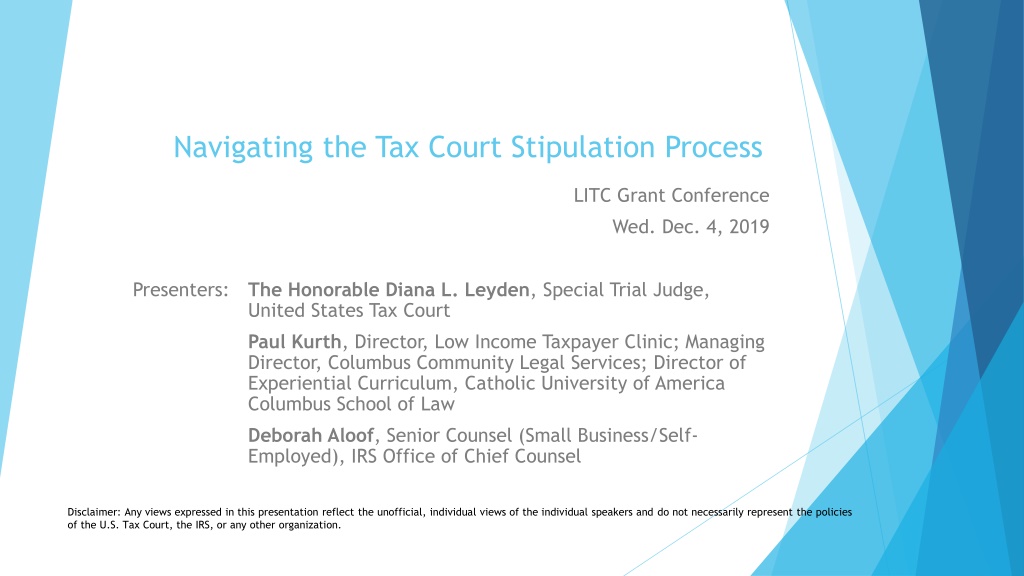

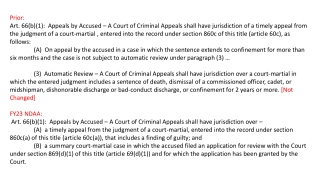

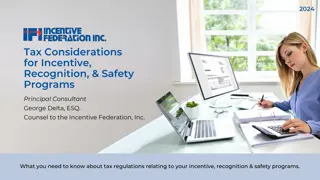
![Town of [Town Name] Real Estate Tax Rates and FY 2024 Budget Summary](/thumb/62211/town-of-town-name-real-estate-tax-rates-and-fy-2024-budget-summary.jpg)
